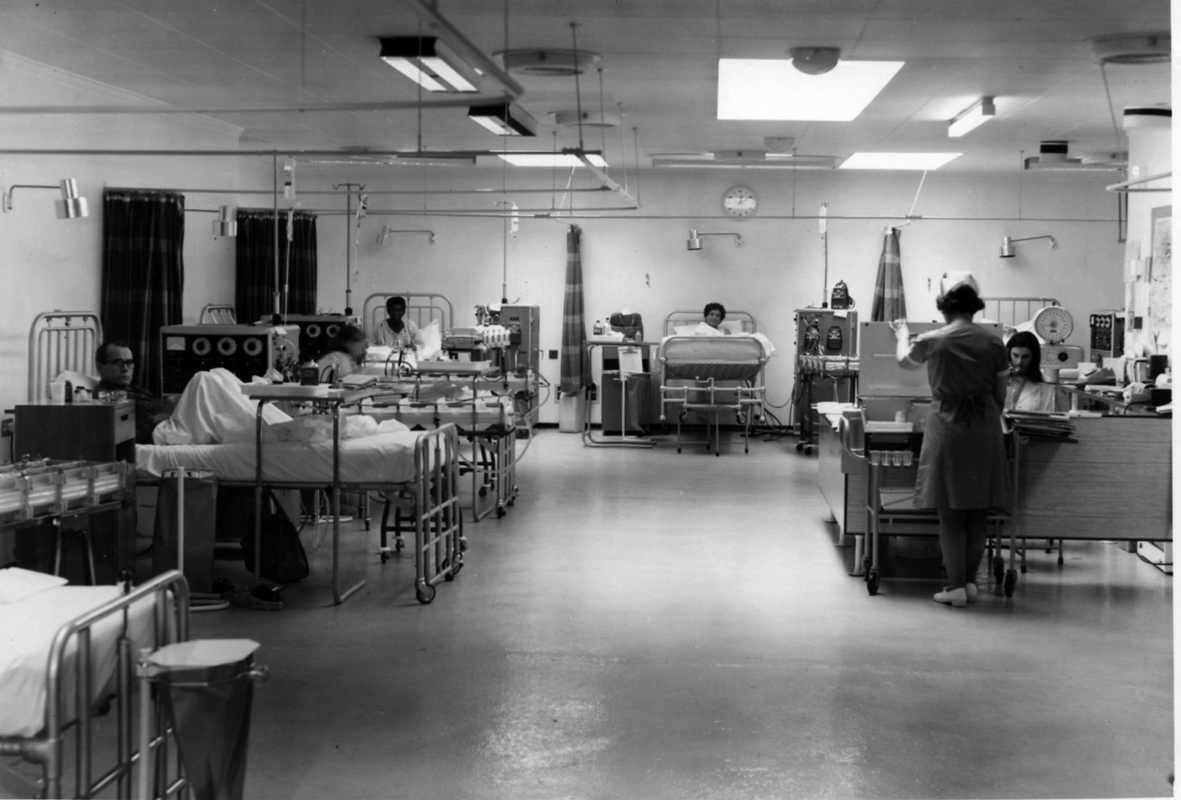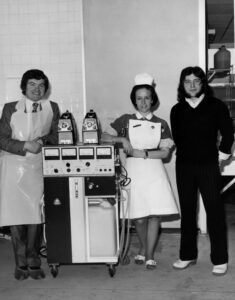
London – Kings
The new unit in 1969
The King’s Renal Unit was founded by Dr Victor Parsons DM, FRCP, always affectionately known as VP. It was started in the mid 1960s in a converted ward area called the “Pilot Unit”, using Travenol-Kolff dialysis machines, later replaced by Lucas MK 1 machines.
VP fought hard to get a better unit established, and eventually succeeded in 1968 when a purpose built unit was erected on the Dulwich Hosptial site, part of the King’s group run by Camberwell Health Authority. It opened in June 1968, fully equippped with all the support areas required, including a central water treatment plant, air conditioning, and its own emergency generator. It had ten stations and an isolation cubicle. It had its own dedicated support team, including technicians, dietitians, community nurses and social workers. The site had previously been tennis courts, a loss petitioned against in vain by King’s medical students.
VP held strong religious convictions and this was reflected in his approach to operating the unit. He adopted a very “hands on” approach and took a personal interest in all aspects of the running of the unit. He held weekly group meetings where staff at all levels were encouraged to attend and take part.
Places on a chronic haemodialysis programme in the 1970s were at a premium. Many units adopted a selection criteria, some based on age or other risk factors, notably Hepatitis B. VP would have none of this and accepted many patients refused treatment by other units. This resulted in a high average patient age, and a small cohort of high-risk Hep B patients. Another consequence of this was a wide geographical spread of patients ranging from Norfolk to Dorset and all counties in between. A home haemodialysis (HD) programme was needed to increase capacity.
The unit’s liberal policy led to some rather unusual “homes” . The unit once converted a room on the top floor of the Sudanese Embassy in London, as a dialysis facility for one of the Embassy staff. It also installed a dialysis facility in a cell of the hospital wing of HMP Wandsworth, and trained prison officers to operate it. This was to treat a convicted Colombian drug smuggler who had gone into chronic renal failure. This caused great controversy at the time, due to the shortage of equipment for NHS patients. The equipment was sabotaged by other inmates on more than one occasion.
The home dialysis programme peaked with around 50 patients being treated. A night dialysis programme was established to treat patients who were fully trained, but for various reasons, were unable to go on home based treatment. When patients and their relatives were being trained for home dialysis it was impractical for them to commute long distances daily. For this reason they were accommodated in a small local hotel. This became such a regular occurrence the hotel almost became part of the service.
The haemodialysis programme combined with a small but developing transplant programme run by Mick Bewick, meant the total patient cohort had now become quite considerable. The hospital unit was increased to 20 stations, and a transplant outpatient clinic was added.
A normal lifestyle, with obvious limitations, was encouraged. To embrace this ethos, two holiday facilities were created. This was achieved with great help from a very active and enthusiastic Renal Patients Association. Haemodialysis equipment was installed in two static holiday caravans located on the Norfolk and Dorset coasts. This posed some logistical problems as the caravan doors were too narrow to get the equipment into the treatment room, so the machine had to be man-handled in through the rear window. On one occasion the machine became stuck, and two local groundsmen were recruited to help. This attracted a small audience of holidaymakers, which the helpers took in their stride, taking a bow at the end of proceedings. The Unit also provided some portable Redy dialysis machines for those seeking a more independent holiday.
The relationship between patients and staff at this time, I believe was quite unique, and I am sure replicated in other similar units. The patients were likely to be with us “for the duration”, and the bond between the two groups was very strong. Many patients adopted an ownership mentality and felt very much a part of the service and not a patient of it.
Christmas parties would be arranged for all the patients and attendances of 150 or more were common. Staff would put on a small show to entertain the patients, Gilbert & Sullivan was popular. Staff would also act as bar staff and waiters. There were also occasional special parties such as fancy dress where staff would dress up in outrageous costumes, much to the amusement of the patients.
The bond was particularly strong between home dialysis patients and the staff supporting them in the community. It was not uncommon for staff to attend family functions such as weddings, christenings and sadly funerals.
I know many members of staff who were there during that time, and feel quite proud to have been part of what was as a pioneering era, giving prolonged life to patients who would not otherwise have been treated.
VP retired from medicine to study theology. He went on to become The Reverend Dr Victor Parsons, Curate of All Saints with St Margaret’s parish in South London. He still came back to the unit on a regular basis to act as “godfather” to the staff, offering advice and guidance, both practical and spiritual. He died suddenly in 1995 after undergoing minor surgery. A service of thanksgiving was held for him in the KIng’s College Hospital chapel. The respect he commanded was evident by the chapel being filled to overflowing with staff and patients attending.
In 2005 the Dialysis Unit moved from Dulwich Hospital to it’s current location on the KIng’s College Hospital site.
Further information
- A 1971 article ‘From the Wash House’ (pdf 6.6 Mb) by Dr Victor Parsons and Sister Pamela Wilson (illustrated above to the right of a Lucas Mk 2 dialysis machine with Barry Tomkins), describing their first three years of experience.
- Photos from Barry Tomkins. There are more in reserve.
*To the left in the photo of the dialysis team is Paul Meroney, CEO of a dialysis equipment company called Meltec.
Authorship
Barry Tomkins, updated in 2023 from an original in John Hopewell’s collection. Thanks to Edda Hendry for pulling this together. Edited by Neil Turner.
Last Updated on May 10, 2023 by neilturn
